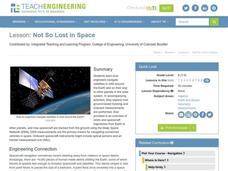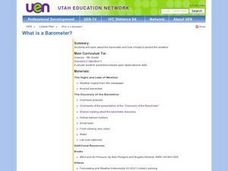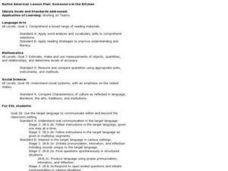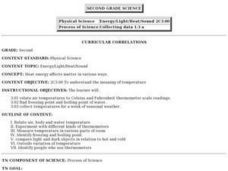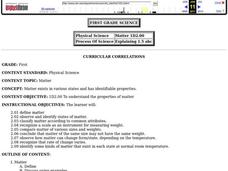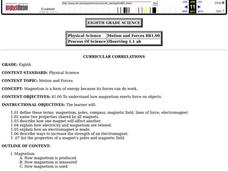Curated OER
As a Matter of Fact
Students rotate through various hands-on experiment stations to explore the concept and properties of different types of matter. They compare some properties of solids, liquids and gases and describe how matter changes from one state to...
Curated OER
Not So Lost in Space
Middle schoolers investigate how engineers navigate satellites in orbit around the Earth and on their way to other planets in the solar system. They study vocabulary words and participate in studying a satellite by learning about times...
Curated OER
Science: What Is a Barometer?
Fourth graders discover how barometers help to predict the weather. Using newspapers, they examine the weather forecast and determine the meaning of high and low as they pertain to pressure. After making cluster diagrams, 4th graders...
Curated OER
Permafrost
Students use a thermometer to analyze soil temperature data to determine which soil sample is normal, and which one is permafrost. In this permafrost lesson plan, students participate in a hands on activity where they identify the active...
Curated OER
Fractions, Equivalent Fractions and Decimals
Learners relate fractions to decimals and find and compare equivalent fractions.
Curated OER
Fractions, Equivalent Fractions and Decimals
Students examine how to relate fractions to decimals and find and compare equivalent fractions.
Curated OER
Native American Lesson Plan: Someone's in the Kitchen
Students use vocabulary necessary to complete cooking activities and tell others about the food. They discuss similarities and differences between Native American and other nationalities' foods made in their families.
Curated OER
Surface Meteorological Observation System (SMOS)
Pupils investigate local surface weather conditions. They log weather conditions for thirty days, develop a graph, plot cloud cover, and compare/contrast the graphed lines of various weather factors.
Curated OER
Finding PI
Students select and use appropriate operations, methods and tools to compute or estimate using whole numbers. They develop and use formulas for determining the circumference and area of circles. Students determine and describe the...
Curated OER
Science Quizzes: Weather Quiz
In this weather science quiz worksheet, students respond to 20 short answer and true or false questions regarding weather and extreme weather.
Curated OER
Map Maker Map Maker
Students create their own maps. In this map making lesson, students go to Microsoft Word and create a chart. They label directions, buildings, streets, and distance.
Curated OER
Exploring Trigonometric Ratios
Learners identify the ratios of trig functions. In this trigonometry lesson, students construct triangles and use it to derive the values of sine, cosine and tangent. They use Cabri software to create the visual of the identities.
Curated OER
Pythagorean Theorem
Learners find the different ratios of a triangle. In this geometry lesson, students use the Pythagorean Theorem to solve for missing sides and angles on a right triangle. They use a robot to create a right triangle.
Curated OER
Chinese Percussion Music
Students investigate Chinese percussion instruments and ensemble performances. They play compositions with Chinese percussion instruments such as small gongs, large gongs and drums.
Curated OER
Heat Energy- Temperature
Second graders investigate the meaning of temperature. They determine what happens to a thermometer when the temperature rises or falls. They place thermometers in different classroom locations in order to compare the temperature in a...
Curated OER
Matter
First graders study and define matter. They observe and identify states of matter along with common attributes and study how matter can change form or change its state depending on temperature.
Curated OER
Motion and Forces
Eighth graders define the terms: magnetism, poles, compass, magnetic field, lines of force, electromagnet. They name two properties shared by all magnets and describe how one magnet will affect another.
Curated OER
Start the Space Flight Time Line
Students research space flight exploration and technology. In small groups, they research a significant event from early time until the start of the space age. A class time line is created from the research groups.
Curated OER
Gravity Lesson
Fifth graders study the effects of mass on gravity. In this gravity lesson, 5th graders make model parachutes and helicopters in order to apply the scientific process and find out the effects of mass on drops of the 2 objects.
Curated OER
From Vibration to Sound
Young scholars observe a series of demonstrations to illustrate wave movement. In this sound wave lesson, students witness how objects create waves when dropped in a dish of water, use a rope and slinky to produce transverse and...
Curated OER
Seeing Interference Fringes with a Telescope
High schoolers construct an interferometer using a simple telescope. In this physics lesson, students explain how light waves create the fringe patterns. They observe patterns made by different objects in the sky and compare them.
Curated OER
Windy Weather
Make wind detectors with paper plates, ribbon, and streamers. Go for walks over an extended period of time to observe and record the effect of the wind on the detectors and other observable objects (leaves, grass, etc.).
Curated OER
Weather Watchers
Students practice using objective and quantitative means to describe and compare the weather. They compile weather conditions and create a spreadsheet to record their findings.
Curated OER
Shake, Rattle And Roll: Studying the Effects of an Earthquake
Learners gauge earthquake intensity by reviewing firsthand accounts. They use the Modified Mercalli Intensity Scale and newspaper articles to estimate the strength and effects of a past earthquake.



